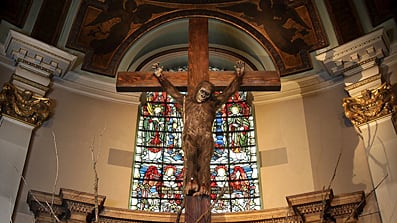With more tiers than a wedding cake, Wednesday’s VIP and VVIP previews for the Frieze Art Fair took place. Meaning that hedge-funders, film stars, and the odd stray supermodel were meandering around London’s Regent’s Park. But that Kevin Spacey, Damien Hirst, and even George Clooney should be at a satellite show just over the road in an 18th-century church was strange. By dusk, 1,400 people had gone through the doors to see The Age of the Marvellous and the works that its Wunderkammer ("cabinet of curiosities") houses.
Click the Image Below to View Our Gallery

Staged in Sir John Soane’s Holy Trinity church, The Age of the Marvellous, is not for the fainthearted. In the altar, there’s Paul Fryer’s sensationally bold The Privilege of Dominion, featuring an ape on a crucifix, rising from a pyre of trees, his head on one side, nestling among the stained glass. The title gives a clue to its ecological preoccupations—for Fryer it’s a work about the fate of the Western Lowland gorillas. Flying toward the sad-faced ape—an emblem, Fryer maintains, of man crucifying the planet—is Departures by Polly Morgan, inspired by a drawing in a book of Victorian inventions. Like balloons, the birds were meant to be able to carry a human aloft in a gilded cage. The contradiction that appealed to her (chiming with Fryer’s tortured animal) is that as the inventive human takes flight, the birds’ freedom is sacrificed.
• Art Beast: The Best of Art, Photography, and DesignFryer might be vulnerable to the charge of sacrilege but his work is already in the collection of French billionaire Francois Pinault. Morgan, too, already has her fair share of fashionable fans (collectors include Kate Moss) but when Departures sold yesterday, it went for around £100,000—three times what her pieces usually sell for. Around these works are pieces by Alastair Mackie who, with Morgan (who only taxidermies animals that die of natural causes) and Fryer, shares a strong eco-aware streak. His Sphere is a perfect round structure made of tiny delicate mouse skulls.
The Age of the Marvellous is curated by London-based American Joseph LaPlaca. His touchstone is E.O. Wilson, the molecular biologist whose 1998 book Consilience argued for art and science as intimately related. Also key is his wish to return to the idea of a gallery as a collection of wonders instead of a freak show. “P.T. Barnum, who of course ran the world’s most famous circus, had a sense of a museum as a place of shock and horror” he says. “That idea was very important to the YBAs [Young British Artists]. I wanted to get away from that, back to a sense of a collection as the sum of all of man’s knowledge—a cause for wonder and awe." The “marvellous,” then, can be scientific, religious, or philosophical. Alyson Shotz’s Ice Network makes a slender breakable sculpture out of the molecular pattern of ice. Martin Sexton’s film of the moon waxing and waning, casting shadows over the face of Socrates, sounds ridiculous, but is hauntingly lovely. The oldest known composition plays. The carpe diem sentiment of the lyrics takes on an extra moving dimension learning that the philosopher’s face is actually made from a 4.5 billion-year-old meteorite.
It’s perhaps at this point (using a meteorite as raw material?) that you might start to "marvel" at the production costs of these works. The scope and ambition comes down to big backing as well as big ideas. LaPlaca’s business partner at his art "producing" company AVA is Mike Platt, co-founder of the BlueCrest hedge fund. Since 2008, they’ve commissioned new works, hoping to build a leading collection. That’s the marvelous fact that explains why the Marvellists are being given the freedom to cast insects in amber (as in Alastair Mackie’s chess set) and make apes with the help of the team from Madame Tussaud’s. In an unusual move, LaPlaca and Platt have applied a movie-producing mentality to the old artist/patron relationship.
In such an altered landscape, it’s something of an irony that a heavy hitting hedgie should be at the center of one of the runaway successes of this year’s Frieze Art Fair. Last year’s financially disappointing edition took place in the shadow of two spectacles: the collapse of Lehman Brothers and on the same day, the typically circus-like spectacle of Damien Hirst’s $198 million sale of Beautiful Inside My Head Forever (christened by cynics as Beautiful Inside My Bank Balance Forever). When commentators talked optimistically of the collapse cleaning out the market (the best thrives, and the dilettantes slink away), it was hard to be convinced by the Pollyanna approach. A year on at Frieze, business can only be better but, as one key dealer put it to me, “you can gauge the market by the height of women’s heels They’re not that high and some are even in flats.”
Greed was good in the art world as much as anywhere else. And now that big dealers have had to learn to love a six-figure deal instead of seven- and eight-, it’s the more affordable shows of emerging artists that have been some of biggest successes. Almost half the 60 works in The Age of the Marvellous have already sold and it's only been officially open a day. And there are seductive Marvellists at work beyond the vision of a single curator. In Play, a pop up show in Mayfair produced by Paradise Row and Prakke Contemporary, the tactile, visually appealing quality of LaPlaca’s artists is equally present: from the Play-Doh cascading down the walls (watch your heels) in Listen with Your Eyes by Amelia Whitelaw to a roomful of feathers. This is A Kinder Heaven by Olympia Scarry.
The sensuality, and eco-awareness, is also there in the work of Douglas White. His "moon cabinets"—old furniture with moons made of candle wax seeming to float across their surfaces—are gothic and romantic in equal measure. When I was there last Thursday, David Tang bought one before I could even get a price (though at £7000 to £10,000 I was strictly window-shopping). Like a good Marvellist, White’s sources, too, reach to other disciplines. He’s obsessed with the poet Ted Hughes (who was himself moon obsessed).
The sight of guests diving into A Kinder Heaven like it was a giant pillow fight couldn’t be a better image for the way in which this new generation has been embraced in London this week. At Holy Trinity Church, if the Marvellists needed any further endorsement, this morning, even London’s most famous collector, Charles Saatchi, went to see what all the fuss was about.
Plus: Check out Art Beast for galleries, interviews with artists, and photos from the hottest parties.
Olivia Cole writes for the Spectator and the London Evening Standard. An award-winning poet, her first collection, Restricted View , will be published this fall.






